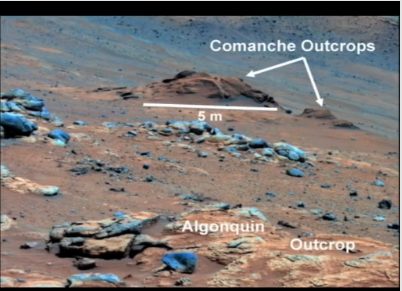 Rocks examined by NASA’s Mars rover Spirit hold evidence of an ancient wet, non-acidic environment that may have been favorable for life. Confirming this mineral clue took four years of analysis by several scientists.
Rocks examined by NASA’s Mars rover Spirit hold evidence of an ancient wet, non-acidic environment that may have been favorable for life. Confirming this mineral clue took four years of analysis by several scientists.Spirit inspected many rock outcrops, including one called Comanche by scientists. They discovered magnesium iron carbonate makes up about one-fourth of the measured volume in Comanche samples. That is a tenfold higher concentration than any previously identified for carbonate in a Martian rock.
Massive carbonate deposits on Mars have been sought for years without much success. Numerous channels apparently carved by flows of liquid water on ancient Mars suggest the planet was formerly warmer, thanks to greenhouse warming from a thicker atmosphere than exists now. The dense, ancient Martian atmosphere was probably rich in carbon dioxide, because that gas makes up nearly all the very thin, modern atmosphere.
Link to the NES Virtual Campus home page.

It really seems to me that as a whole we are looking at Mars through the wrong end of our time piece. If we were looking for the existence of life in our own solar system we need to look closer to the sun, not further away. Venus would be our number one source for signs of previous life. Venus is also the epitome of Earth’s eventual state.
The Earth lies within the “habitable zone”, we actually lie on the inner edge of the habitable zone that is ever so slowly drifting further out from the Sun. Eventually Earth will no longer be within this “habitable zone” and will become a mirror of what Venus is today. Global warming will naturally reach unprecedented levels, the atmosphere will be completely toxic and the acidic precipitation will eat away all sign of life ever existing.
Once the Earth has evolved into a completely toxic planet that can no longer support any type of life then it will be Mar’s turn to live within the ever moving habitable zone. What we find on Mars now is the very beginning, not some ancient past.